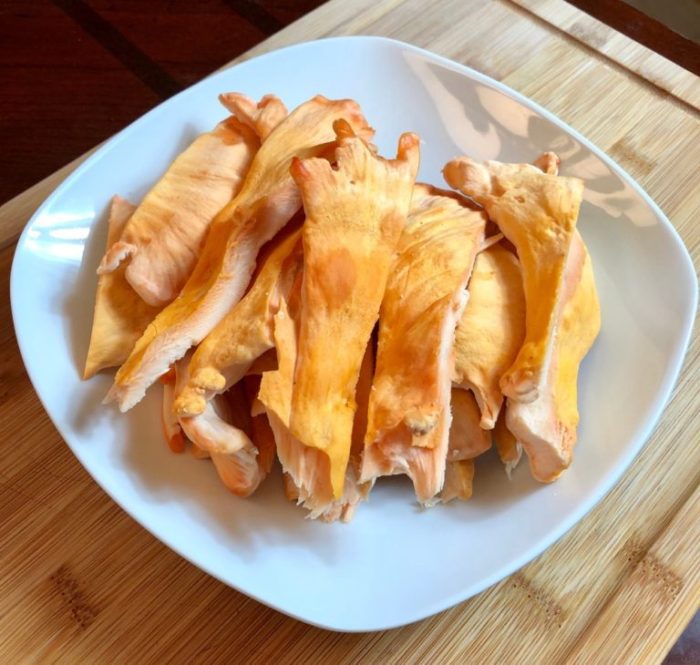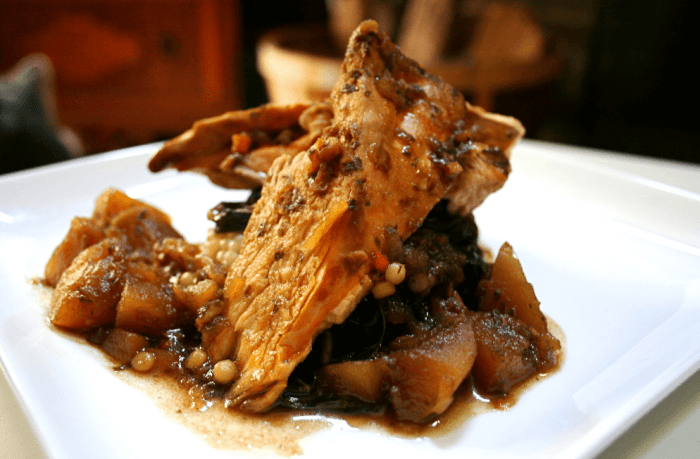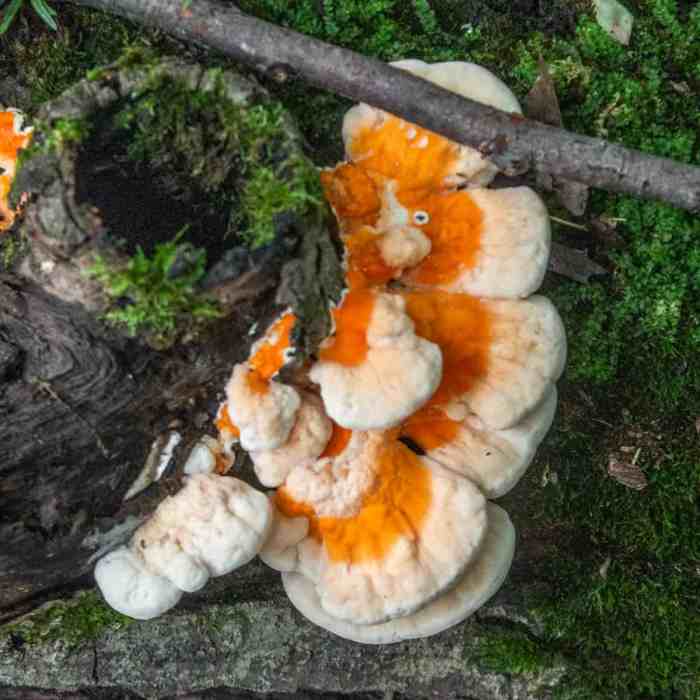
Chicken of the woods recipe – Embark on a culinary journey with chicken of the woods, a vibrant mushroom that tantalizes taste buds with its unique flavors and textures. Its versatility shines in a range of cooking methods, from sautéing to grilling, making it a beloved ingredient among mushroom enthusiasts.
From its nutritional value to foraging tips, this guide delves into the fascinating world of chicken of the woods, offering insights and inspiration for culinary creations.
Culinary Delights of Chicken of the Woods

Chicken of the woods, known for its succulent and versatile culinary profile, stands out among edible mushrooms. Its unique flavors and textures have captivated the palates of gourmands worldwide.
Flavor Profile
Chicken of the woods boasts a mild, savory flavor reminiscent of chicken, making it a delectable substitute for meat in various dishes. It exhibits a slightly nutty and earthy undertone, adding complexity to soups, stews, and stir-fries.
Texture, Chicken of the woods recipe
The texture of chicken of the woods varies depending on its age and growing conditions. Young specimens possess a tender, almost velvety texture that becomes firmer and meatier as they mature. This versatility allows for a wide range of culinary applications, from sautéing to grilling and roasting.
Chicken of the woods, a flavorful and sought-after edible mushroom, can be enjoyed in a variety of ways. One popular recipe involves sautéing the mushrooms with butter, garlic, and herbs. For a more in-depth guide, check out this chicken of the woods recipe .
Culinary Profile Comparison
To further highlight the culinary merits of chicken of the woods, here’s a comparative table with other popular edible mushrooms:
| Mushroom | Flavor | Texture |
|---|---|---|
| Chicken of the Woods | Mild, savory, slightly nutty | Tender to firm, depending on age |
| Shiitake | Umami-rich, earthy | Meaty, slightly chewy |
| Oyster | Mild, slightly seafood-like | Tender, succulent |
| Portobello | Meaty, earthy | Firm, chewy |
Preparation Techniques for Chicken of the Woods
Chicken of the woods is a versatile mushroom that can be prepared in various ways. Before cooking, it’s essential to clean and prepare it properly. Here are some tips:
Cleaning
To clean chicken of the woods, remove any dirt or debris from the surface. Cut off any tough or woody stems. Use a damp cloth or brush to gently wipe away any remaining dirt or grime. Avoid washing it with water, as it can absorb excess moisture and become soggy.
Cooking Methods
Chicken of the woods can be cooked using various methods, each with its unique benefits:
- Sautéing:Sautéing is a quick and easy method that brings out the mushroom’s earthy flavor. Heat some oil in a skillet and cook the chicken of the woods over medium heat until tender and slightly browned.
- Roasting:Roasting is a great way to caramelize the mushrooms and enhance their sweetness. Preheat your oven to 400°F (200°C) and toss the chicken of the woods with olive oil, salt, and pepper. Roast for 20-25 minutes, or until tender and slightly crispy.
- Grilling:Grilling imparts a smoky flavor to the chicken of the woods. Preheat your grill to medium-high heat and grill the mushrooms for 5-7 minutes per side, or until tender and slightly charred.
Preparation Techniques Summary
Here’s a table summarizing the preparation techniques and their respective benefits:
| Technique | Benefits |
|---|---|
| Sautéing | Quick and easy, enhances earthy flavor |
| Roasting | Caramelizes mushrooms, enhances sweetness |
| Grilling | Imparts smoky flavor, slightly charred |
Recipe Explorations with Chicken of the Woods: Chicken Of The Woods Recipe

Chicken of the woods is a versatile mushroom that can be used in various dishes, from soups and stews to stir-fries and pizzas. Here are a few popular recipes that showcase its culinary potential:
Popular Chicken of the Woods Recipes
- Chicken of the Woods Soup:A comforting and flavorful soup made with chicken of the woods, vegetables, and broth.
- Chicken of the Woods Stew:A hearty and savory stew with chicken of the woods, beef, vegetables, and red wine.
- Chicken of the Woods Stir-Fry:A quick and easy stir-fry with chicken of the woods, vegetables, and your favorite sauce.
- Chicken of the Woods Pizza:A unique and delicious pizza topped with chicken of the woods, cheese, and vegetables.
- Chicken of the Woods Tacos:A flavorful and satisfying taco filling made with chicken of the woods, salsa, and your favorite toppings.
The table below provides a comparison of these recipes, including ingredients, preparation time, and flavor profiles:
| Recipe | Ingredients | Preparation Time | Flavor Profile |
|---|---|---|---|
| Chicken of the Woods Soup | Chicken of the woods, vegetables, broth, seasonings | 60 minutes | Comforting, savory, umami |
| Chicken of the Woods Stew | Chicken of the woods, beef, vegetables, red wine, seasonings | 90 minutes | Hearty, rich, full-bodied |
| Chicken of the Woods Stir-Fry | Chicken of the woods, vegetables, sauce | 30 minutes | Quick, savory, adaptable |
| Chicken of the Woods Pizza | Chicken of the woods, cheese, vegetables, pizza dough | 45 minutes | Savory, cheesy, umami |
| Chicken of the Woods Tacos | Chicken of the woods, salsa, toppings | 20 minutes | Savory, spicy, flavorful |
Nutritional Value and Health Benefits

Chicken of the woods is a nutritional powerhouse, offering an impressive array of vitamins, minerals, and antioxidants. Its high protein content makes it a valuable plant-based protein source, while its fiber content promotes digestive health and satiety.
Beyond its macronutrient profile, chicken of the woods boasts a wealth of micronutrients, including vitamin C, vitamin D, potassium, and iron. These nutrients contribute to immune system function, bone health, and overall well-being.
Nutritional Composition
| Nutrient | Amount per 100g |
|---|---|
| Protein | 12-15g |
| Fiber | 6-8g |
| Vitamin C | 20-30mg |
| Vitamin D | 10-15IU |
| Potassium | 300-400mg |
| Iron | 2-3mg |
Health Benefits
The nutritional composition of chicken of the woods translates into several potential health benefits, including:
- Immune system support:Vitamin C and other antioxidants in chicken of the woods may help boost immune function and protect against infections.
- Antioxidant properties:The antioxidants in chicken of the woods can help neutralize free radicals, which are unstable molecules that can damage cells and contribute to chronic diseases.
- Bone health:Vitamin D in chicken of the woods supports calcium absorption, essential for strong and healthy bones.
- Digestive health:The fiber in chicken of the woods promotes regular bowel movements and supports a healthy digestive system.
Foraging and Identification Tips

Chicken of the woods can be found in abundance during the fall months, typically from late summer to early winter. It’s important to note that this mushroom has several lookalikes, some of which are poisonous. Therefore, it’s crucial to learn how to correctly identify chicken of the woods before foraging.
When foraging for chicken of the woods, it’s essential to observe its distinct characteristics. The mushroom typically grows in clusters or shelves on the sides of trees, often at the base or on fallen logs. It features a bright orange to yellow coloration, with a velvety texture and a soft, fleshy consistency.
The underside of the mushroom exhibits pores instead of gills, and it tends to be white or cream-colored.
If you’re looking for a unique culinary experience, consider trying the chicken of the woods recipe . This versatile mushroom can be grilled, fried, or added to soups and stews for a rich and savory flavor.
Key Characteristics and Habitats
To assist in foraging, here’s a table summarizing the key characteristics and habitats of chicken of the woods:
| Characteristic | Details |
|---|---|
| Growth Form | Clusters or shelves on trees |
| Color | Bright orange to yellow |
| Texture | Velvety |
| Consistency | Soft and fleshy |
| Undersurface | Pores (not gills) |
| Color of Pores | White or cream |
| Habitat | On or near oak, maple, or beech trees |
Safety Tips for Avoiding Poisonous Lookalikes
To ensure safety while foraging, it’s essential to avoid poisonous lookalikes. One of the most common is the jack-o’-lantern mushroom, which shares a similar orange color but has gills instead of pores. Additionally, the sulfur shelf mushroom can be mistaken for chicken of the woods, but it has a sulfur-like odor and grows on coniferous trees.
When in doubt, it’s always best to consult with an experienced mushroom forager or refer to reliable field guides.
Outcome Summary

As we conclude our exploration of chicken of the woods, it’s clear that this mushroom is not just a culinary delight but a testament to nature’s bounty. Its unique flavors, health benefits, and ease of preparation make it a must-try for any food lover.
So, venture into the woods, identify this hidden treasure, and let your taste buds experience the magic of chicken of the woods.
User Queries
What is the best way to clean chicken of the woods?
Gently brush off any dirt or debris with a soft brush. If needed, use a damp cloth to wipe away any stubborn grime.
Can I eat chicken of the woods raw?
It’s not recommended to consume chicken of the woods raw as it may cause stomach upset. Cooking helps enhance its flavors and digestibility.
How do I store chicken of the woods?
Store fresh chicken of the woods in a paper bag in the refrigerator for up to 5 days. Cooked chicken of the woods can be stored in an airtight container in the refrigerator for up to 3 days.






